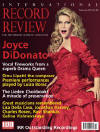Texte paru dans: / Appeared in:
*

International Record Review - (02/2013)
Pour
s'abonner / Subscription information
Virgin Classics
VIR0709442

Code-barres / Barcode : 5099907094422
French pianist David Fray, now in his early thirties, came to my attention with a distinctive and imaginative recording that paired Bach’s Fourth Partita with Boulez’s Notations (it was reviewed in these pages in July/August 2007). Although he has since recorded music by Schubert, Mozart and Liszt, he is now perhaps best known for his Bach playing, including strong accounts of four Bach concertos in which he conducts the Bremen German Chamber Orchestra from the keyboard. Rehearsals of those concertos captured on a DVD by Bruno Monsaingeon, entitled ‘J. S. Bach : Swing , Sing and Think’, in which Fray flirts with the camera and generally behaves and sounds more than a bit like the eccentric young Glenn Gould. Indeed, in some circles he has been called ‘the new Gould’. While the two pianists are superficially similar, including a penchant for incisive rhythms, crisp articulation and fast tempos, I would not want to push that comparison too far.
He opens the Second Partita with stark, bold chords that are nicely over-dotted but which lack harmonic tension and grandeur. In the following Andante section the melody is thin and wispy and the accompaniment is even thinner, with small nuances of tone and tempo sounding applied rather than natural. Generally, these characteristics apply to Fray’s slow playing, which often sounds distant and unengaged. That quality is not helped by his literal approach to repeats, which could have benefited from small changes of touch, tone or ornamentation. He fares better in livelier music, especially the Courantes of both Partitas and the Tempo di gavotta of the Sixth Partita.
In the opening of the imposing Sixth Partita, one of Bach’s most challenging keyboard works, Fray features almost Chopinesque nuances of tempo and dynamics, exploiting the instrument fully before settling down to a refreshingly direct delivery of the fugal main section. In the final Gigue, hard tone and punchy rhythms cause the dance to sound more like a grim march. In both Partitas, I miss the imaginative and characterful playing of Angela Hewitt and András Schiff, who invest each movement with a real feeling for the dance elements. Although readers probably won’t be interested in this disc primarily for the Toccata, that work receives one of the best performances I know among piano versions. Alternately improvisatory, bold and lyrical, it manages to hold together unusually well.
The recorded sound throughout the disc is somewhat
distant and generalized, unlike the vivid close sound accorded Hewitt and
Schiff. Despite my qualms, I will be interested to hear more of Fray’s Bach,
for enough of his earlier accounts have impressed me.
Fermer la fenêtre/Close window
Cliquez l'un ou l'autre
bouton pour découvrir bien d'autres critiques de CD
Click either button for many other reviews


